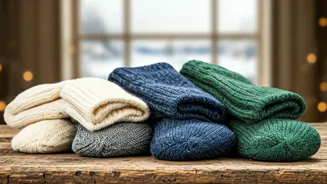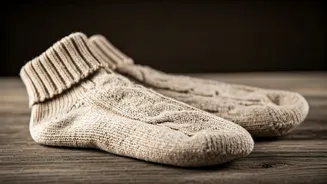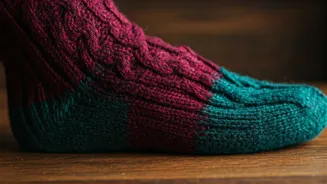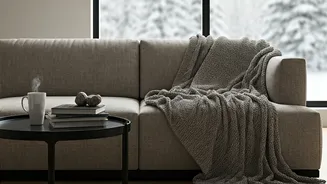Materials for Warmth
The material used in winter socks is crucial for warmth and comfort. Wool is a classic choice, known for its excellent insulation properties, even when
wet. It traps air, providing a warm barrier against the cold, and wicks away moisture to keep feet dry. Synthetic materials like polyester and acrylic are also popular, offering durability and quick-drying capabilities, often blended with other fibers to enhance their performance. Merino wool is often praised for being soft and non-itchy. Blends that incorporate silk can add another layer of softness and thermal insulation. Choosing the right material depends on individual needs and preferences. Consider the intended activity; for example, hiking socks need more robust materials compared to socks worn indoors.
Construction Matters Most
The construction of a winter sock greatly impacts its warmth and durability. Socks with a thicker knit tend to be warmer, as they trap more air within the fibers. The density of the knit also affects the sock's durability; socks with a tighter knit are generally more resilient. Look for features such as reinforced heels and toes, which significantly extend the sock's lifespan, particularly in areas of high wear. Consider the design too: a seamless toe construction reduces friction and prevents blisters, which is especially important for active use. Sock construction can significantly affect their fit and performance, so make sure to select the correct construction based on the intended purpose.
Fit and Sizing Guide
Proper fit is essential for the comfort and effectiveness of winter socks. Socks that are too tight can restrict circulation and make feet feel colder, while socks that are too loose can bunch up and cause blisters. Always check the sizing chart provided by the manufacturer. Consider the thickness of the socks and how they will fit with your shoes or boots. It's often beneficial to try on socks with the shoes you plan to wear them with. If you're between sizes, generally it's better to choose the larger size for more comfort. Pay attention to the heel and toe construction to ensure a snug, comfortable fit, allowing your feet to move naturally while keeping them warm and well-protected from the cold.
Sock Types Explored
Different types of winter socks cater to various needs and activities. Thermal socks, often made from thick wool or synthetic blends, are designed for extreme cold conditions. Hiking socks feature reinforced construction and moisture-wicking properties, crucial for outdoor adventures. Compression socks can enhance blood circulation and reduce swelling, beneficial for both athletes and individuals with circulation issues. Everyday socks blend comfort and warmth, suitable for daily wear. Choose socks based on your activity: thermal socks for extreme cold, hiking socks for outdoor adventures, and everyday socks for general warmth. Considering the intended use will greatly influence the type of sock to choose.
Care and Maintenance
Proper care and maintenance can extend the life and effectiveness of your winter socks. Always follow the care instructions provided by the manufacturer. Typically, wool socks should be washed in cold water to prevent shrinkage and damage. Using a mild detergent designed for delicate fabrics or wool is recommended. Avoid harsh chemicals or bleach, which can degrade the fibers. Allow socks to air dry or tumble dry on a low setting; excessive heat can damage the fibers. Store socks properly in a clean, dry place to prevent mildew and damage. Regular washing and proper storage will help maintain their shape, warmth, and overall performance, ensuring your socks last longer.









